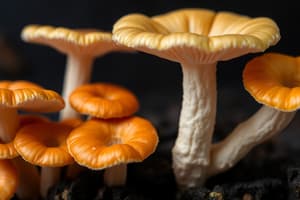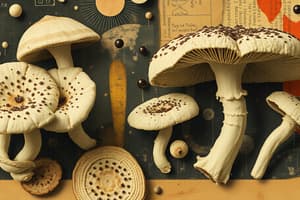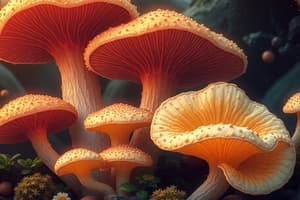Podcast
Questions and Answers
What is the primary structural form in which yeasts exist?
What is the primary structural form in which yeasts exist?
- Filamentous
- Multicellular
- Unicellular (correct)
- Dimorphic
Which of the following characteristics applies to moulds?
Which of the following characteristics applies to moulds?
- Reproduce only by budding
- Nutritious for human consumption
- Multicellular and have hyphae (correct)
- Form pseudohyphae
Where are yeasts commonly found?
Where are yeasts commonly found?
- Exclusively in water
- On fruit and in the oral cavity (correct)
- Only in decaying matter
- Only in soil
What is a significant health risk associated with yeasts?
What is a significant health risk associated with yeasts?
Which color is commonly associated with yeasts?
Which color is commonly associated with yeasts?
What is the main difference between yeasts and moulds in terms of cell type?
What is the main difference between yeasts and moulds in terms of cell type?
What type of structures do yeasts form instead of true hyphae?
What type of structures do yeasts form instead of true hyphae?
In what conditions can yeasts grow?
In what conditions can yeasts grow?
What is a notable risk associated with moulds?
What is a notable risk associated with moulds?
What is the primary method of reproduction in yeasts?
What is the primary method of reproduction in yeasts?
What form does Candida take when it exists as mould?
What form does Candida take when it exists as mould?
Which Candida infection is characterized by white patches in the mouth or throat?
Which Candida infection is characterized by white patches in the mouth or throat?
Which organism is primarily responsible for Invasive Aspergillosis?
Which organism is primarily responsible for Invasive Aspergillosis?
Which of the following is NOT a common infection associated with dermatophytes?
Which of the following is NOT a common infection associated with dermatophytes?
What is the characteristic feature of a fungal colony formed by moulds?
What is the characteristic feature of a fungal colony formed by moulds?
Which condition is often exacerbated in individuals with asthma due to fungal presence?
Which condition is often exacerbated in individuals with asthma due to fungal presence?
Which fungus is linked to causing systemic infections in immunocompromised patients?
Which fungus is linked to causing systemic infections in immunocompromised patients?
What distinguishes a pseudohypha from true hyphae in yeasts?
What distinguishes a pseudohypha from true hyphae in yeasts?
Which type of organism is Cryptococcus neoformans classified as?
Which type of organism is Cryptococcus neoformans classified as?
What type of cell structure distinguishes yeasts from moulds?
What type of cell structure distinguishes yeasts from moulds?
Which statement accurately describes the habitat of moulds?
Which statement accurately describes the habitat of moulds?
What is a key characteristic of the appearance of moulds?
What is a key characteristic of the appearance of moulds?
Which of the following statements is true regarding the oxygen requirements of yeasts and moulds?
Which of the following statements is true regarding the oxygen requirements of yeasts and moulds?
Which characteristic differentiates the reproductive capabilities of yeasts from moulds?
Which characteristic differentiates the reproductive capabilities of yeasts from moulds?
What health risk is primarily associated with mould exposure?
What health risk is primarily associated with mould exposure?
Which color is typically less associated with yeasts compared to moulds?
Which color is typically less associated with yeasts compared to moulds?
Flashcards
Fungi
Fungi
Eukaryotic organisms that can exist as either yeast or mold.
Yeast
Yeast
Grow as large, single cells. Common in oral cavities and vaginal areas.
Mold
Mold
Multicellular structures composed of hyphae and reproduce using spores.
Dimorphism (Fungi)
Dimorphism (Fungi)
Signup and view all the flashcards
Pseudohyphae
Pseudohyphae
Signup and view all the flashcards
Candida albicans
Candida albicans
Signup and view all the flashcards
Hyphae
Hyphae
Signup and view all the flashcards
Mycelium
Mycelium
Signup and view all the flashcards
Commensal Fungi
Commensal Fungi
Signup and view all the flashcards
Candidiasis
Candidiasis
Signup and view all the flashcards
Oral Thrush
Oral Thrush
Signup and view all the flashcards
Aspergillosis
Aspergillosis
Signup and view all the flashcards
Dermatophytosis
Dermatophytosis
Signup and view all the flashcards
Tinea pedis
Tinea pedis
Signup and view all the flashcards
Cryptococcosis
Cryptococcosis
Signup and view all the flashcards
Cryptococcal Meningitis
Cryptococcal Meningitis
Signup and view all the flashcards
Histoplasmosis
Histoplasmosis
Signup and view all the flashcards
Hyphae
Hyphae
Signup and view all the flashcards
Budding or Fission
Budding or Fission
Signup and view all the flashcards
Mold Reproduction
Mold Reproduction
Signup and view all the flashcards
Mold growth conditions
Mold growth conditions
Signup and view all the flashcards
Yeast growth conditions
Yeast growth conditions
Signup and view all the flashcards
Study Notes
Fungi Characteristics
- Eukaryotic organisms.
- Candida is a significant fungus in dentistry.
- Exist in two structural forms: yeast and mold.
- Some fungi are dimorphic (can be both yeast and mold).
Yeast Characteristics
- Grow as large, single cells (unicellular).
- Common habitats: fruit, mammalian stomachs, oral cavities, vaginal areas.
- Typically white and thready, oval-shaped.
- Lack true hyphae; instead, form pseudohyphae (multicellular structures).
- Not a sporing species.
- Less colorful than molds; often colorless or collectively yellow-creamy.
- Can grow in both aerobic and anaerobic conditions.
- Pose infection risks to immunocompromised individuals.
- Often exhibit lateral projections (daughter cells) budding from the mother cell.
- Some reproduce via binary fission.
- Candida forms pseudohyphae in the oral cavity.
Mold Characteristics
- Grow as multiple tubular branches (multicellular).
- Typically found in damp, dark, or humid environments.
- Fluffy appearance; various shapes.
- Possess microscopic filaments called hyphae.
- Are sporing fungi.
- Exhibit diverse colors (orange, green, black, brown, pink, purple).
Fungi: Key Characteristics
- Eukaryotic organisms with a true nucleus and organelles.
- Candida, a dimorphic fungus (exists as yeast and mold), is highly relevant in dentistry.
Yeasts
- Reproduce via budding or binary fission.
- Budding creates daughter cells; these can form pseudohyphae (elongated chains).
- Candida albicans, a common oral yeast, forms pseudohyphae.
Molds
- Multicellular structures composed of hyphae (thread-like filaments containing cytoplasm and organelles).
- Hyphae aggregate to form mycelium (the mold colony).
- Reproduction is through asexual or sexual spores.
Commensal Fungi
- Fungi like Candida are part of the normal flora in the oral cavity, vagina, and other body sites.
- Usually harmless, but can cause infections in immunocompromised individuals.
Candida Infections (Candidiasis)
- Caused by Candida species (primarily Candida albicans).
- Oral thrush: White patches in the mouth/throat; common in infants and those with weakened immunity.
- Vaginal candidiasis: Yeast infection with itching, discharge, and discomfort.
- Systemic candidiasis: Life-threatening bloodstream infection; prevalent in hospitalized/immunocompromised patients.
Aspergillosis
- Caused by Aspergillus species (Aspergillus fumigatus is most common).
- Allergic bronchopulmonary aspergillosis (ABPA): Allergic lung reaction; common in asthma/cystic fibrosis patients.
- Aspergilloma ("fungus ball"): Mass of fungal hyphae in lung cavities; occurs in people with pre-existing lung disease.
- Invasive aspergillosis: Severe infection impacting lungs, brain, and other organs; affects mostly those with compromised immunity.
Dermatophytosis (Tinea/Ringworm)
- Caused by Trichophyton, Microsporum, and Epidermophyton species.
- Tinea pedis (athlete's foot): Fungal foot infection causing itching, redness, and peeling.
- Tinea corporis (body ringworm): Circular, red, scaly patches on the skin.
- Tinea capitis: Fungal scalp infection leading to hair loss and scaly patches.
Cryptococcosis
- Caused by Cryptococcus neoformans.
- Pulmonary cryptococcosis: Lung infection; primarily affects immunocompromised individuals (e.g., those with HIV/AIDS).
- Cryptococcal meningitis: Serious brain and spinal cord infection; symptoms include headaches, fever, and neurological issues.
Histoplasmosis
- Caused by Histoplasma capsulatum (dimorphic; yeast form in the body).
- Pulmonary histoplasmosis: Lung infection from inhaling spores in soil (often near bird or bat droppings); can mimic pneumonia.
- Disseminated histoplasmosis: Severe, systemic disease spreading to other organs; common in immunocompromised individuals.
Yeast Characteristics
- Unicellular organisms, growing as large single cells.
- Found in various locations including fruits, the stomach, oral cavity, and vagina.
- Typically appear white or creamy, with a less diverse color range than molds.
- Form pseudo-hyphae, which are chains of cells that resemble true hyphae but lack cross-walls.
- Reproduction is primarily through budding, a form of asexual reproduction. They do not produce spores.
- Can thrive in both aerobic (with oxygen) and anaerobic (without oxygen) environments.
- Infections are a concern mainly for immunocompromised individuals.
Mold Characteristics
- Multicellular organisms, growing as a network of tubular branches called hyphae. True hyphae have cross-walls.
- Found thriving in damp, dark, or humid environments.
- Exhibit a fluffy appearance and a wider array of colors including orange, green, black, and others.
- Reproduce using spores, which are readily dispersed and contribute to their widespread growth.
- Require oxygen for growth (aerobic).
- Can trigger allergic reactions and respiratory issues in susceptible individuals.
Key Differences
- Yeasts are unicellular while molds are multicellular.
- Yeasts typically do not produce spores, while molds do.
- Molds display extensively greater color diversity.
- Yeasts can grow in both aerobic and anaerobic conditions, whereas molds require aerobic environments.
Studying That Suits You
Use AI to generate personalized quizzes and flashcards to suit your learning preferences.



